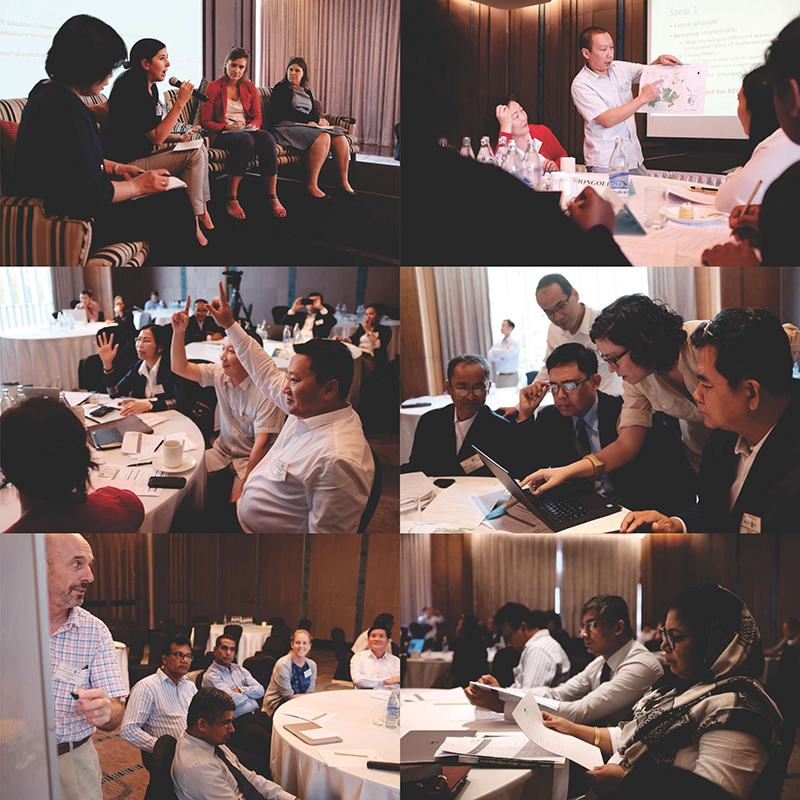REDD+ countries in the Asia-Pacific region prioritised Investment Planning and results-based payments (RBPs) as the preferred topic for the 2017 Asia-Pacific UN-REDD regional knowledge exchange, which was held in Bangkok on 10-12th October 2017. The event was attended by 28 participants from ten UN-REDD Partner Countries in the region as well as representatives of indigenous peoples and civil society organisations. While over 40 percent of the participants were women, and around 20 percent of country delegates came from outside the forestry sector.
This two-and-a-half-day event was structured around 3 sessions:
-
Day 1: Investment planning for implementation (REDD+ phase 1)
-
Day 2: Mobilizing finance for REDD+ implementation (REDD+ phase 2)
-
Day 3: REDD+ Results-based payments (REDD+ phase 3)
The knowledge exchange was ever more timely given the meeting of the Green Climate Fund (GCF) Board held one week before the event. Indeed, a member of the GCF Secretariat attended the UN-REDD event and updated Asia-Pacific delegates on the recently adopted request for proposals for the pilot programme for REDD+ RBPs under the UNFCCC (Decision B.18/07) and specific conditions and requirements to access it. A rich Q&A session ensued, with country participants taking advantage of this opportunity to ask questions on such a relevant topic as some countries have now completed the Warsaw Framework for REDD+ and are looking forward to receive RBPs under the UNFCCC.
Participants were presented with cutting-edge information from the region and around the world on the requirements and best practices in REDD+ investment planning and associated resource mobilisation. The inter-regional cross-fertilisation was recognised as an element of significant value added by country delegates, who had a chance to learn from Latin American experiences with operationalising and implementing REDD+. A representative of Ecuador’s Ministry of Environment attended the Bangkok event, sharing her country’s REDD+ progress, with regards to developing a financing strategy, integrating and managing information for monitoring and evaluation (M&E) of REDD+, as well as recommendations for countries willing to respond to the call for proposal of RBPs. A representative of Chile’s National Forestry Corporation (CONAF) also participated remotely, and presented his country’s methodology for costing and budgeting of the National REDD+ Strategy and discussed related opportunities and challenges.

Some of the main lessons harvested throughout the various sessions included:
-
Importance of working on investment planning and funding mechanisms in parallel and ensuring feedback between the specialised teams working on both, as the Implementation Plan and the National REDD+ Fund will strongly influence one another.
-
There are existing information systems for monitoring programmes and projects (example of Ecuador), so countries do not need to “start from scratch” (but harmonisation may be an issue).
-
An M&E system for REDD+ implementation should not be an after-thought or add-on; the earlier a country sets systems in place for this the better (Ecuador’s example).
-
One of the main reasons why Trust Funds seem to be the preferred option as funding mechanism to channel REDD+ public finance (investment/RBPs) relates to National REDD+ Funds’ flexibility, as they can accommodate various sectors, stakeholders, and different donor requirements.
-
However, National Funds are not a “silver bullet” (perfect solution). It is important to ensure that Funds support what is important for REDD+ interventions, especially that investments are guided by the National Plan. Finally, multiple mechanisms – including direct budget support, or domestic carbon markets – will most probably be required for various interventions and actors. It is therefore important to take stock of what is existing, see how to bridge gaps, and coordinate.
-
Importance of working on a robust and comprehensive financing strategy as part of the investment planning process, looking at domestic and international, public and private sources of finance.
You can find more information on the event and all supporting materials on the Asia-Pacific Knowledge Exchange page here.


